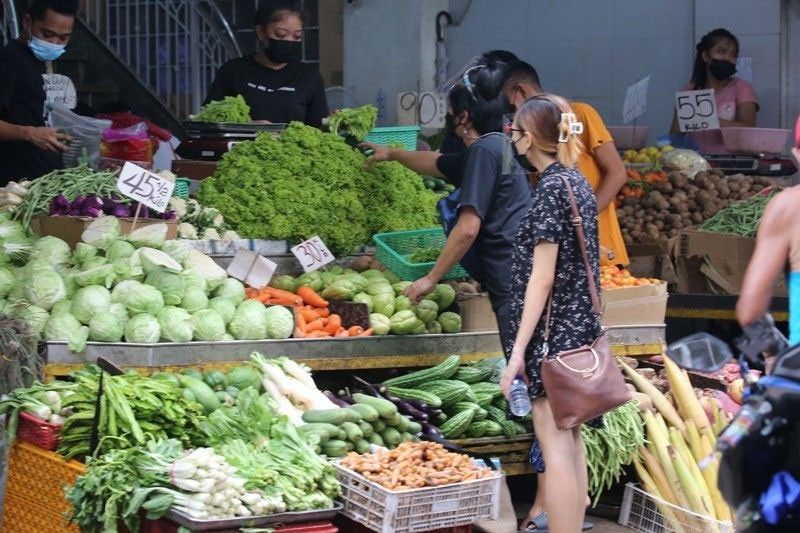Inflation slides to 3.6% in December, lowest in 2021

MANILA, Philippines — Prices of goods and services in the country accelerated faster than government expectations last year despite clocking in 2021’s lowest inflation rate in December, the Philippine Statistics Authority (PSA) said.
Headline inflation, or the rate of increase in the consumer price index, slid to 3.6 percent in December from 4.2 percent in November.
The December figure is the lowest inflation rate for 2021 and is well below the market consensus of 4.1 percent.
Despite the further slowdown in December, full-year inflation reached 4.5 percent, breaching the Bangko Sentral ng Pilipinas (BSP)’s 4.4 percent target for 2021.
This is also significantly higher than the 2.6 percent rate in 2020.
BSP Governor Benjamin Diokno said inflation is projected to ease close to the mid-point of the target range of two to four percent this year and next year.
However, Diokno warned that supply disruptions and farm damage due to Typhoon Odette may result in a temporary uptick in the prices of food items and other necessities over the near term.
“As with previous episodes of natural disasters, the effective implementation of non-monetary government intervention measures to ensure adequate domestic food supply must be sustained in order to mitigate potential supply-side pressures on inflation,” Diokno said.
In a briefing yesterday, PSA head Dennis Mapa said that for the whole of 2021, meat prices, particularly pork, have been contributing significantly to inflation.
In December alone, pork prices in Metro Manila averaged P348 per kilogram, up nearly five percent from P332 a kilo a month earlier.
For provinces outside the capital, prices went up by almost 15 percent to reach P305 a kilo.
Meat is among the top three drivers of inflation in 14 out of 16 regions outside Metro Manila in December.
To temper inflation in meat, especially pork, Socioeconomic Planning Secretary Karl Chua said the government is working to increase local supply and ensure regular unloading of stocks from cold storages.
Chua said that local supply needs to be augmented by pork imports through increased utilization of the minimum access volume (MAV) Plus under lowered tariffs.
Data showed that only around 46 percent or 60,000 metric tons out of 130,000 MT of the MAV Plus with import certificates was utilized.
Chua said the National Economic and Development Authority reiterated its recommendation to extend the validity of Executive Order 133 until December 2022 to help ensure stable pork supply this year.
Further, the slowdown in the December inflation was attributed to the deceleration of the heavily weighted food and non-alcoholic beverages, which contributed 52.8 percent to the overall downtrend.
Food inflation slipped to 3.1 percent in December from 3.9 percent a month earlier due to cheaper food commodities, particularly vegetables, fish and rice.
Similarly, transport inflation fell to 6.1 percent
In particular, petroleum and fuel inflation slid to 29.4 percent in December from 42.1 percent a month ago.
Also contributing to the inflation were increases in the prices of housing, water, electricity, gas and other fuels, which had a 30.5 percent share of the headline rate.
This was largely driven by power rates which increased to 13.6 percent from 10.3 percent.
Rizal Commercial Banking Corp. chief economist Michael Ricafort said the normalization of the inflation base would allow the price movement to stabilize at the three percent levels in the coming months and for the whole of 2022.
He said concerns about the resurgence of COVID cases due to Omicron that led to the return to stricter mobility restriction could slow down global economic recovery.
In turn, this could help ease inflationary pressures going forward, as an unintended consequence by Omicron, thereby justifying the continuation of an accommodative monetary policy stance.
“As a result, the key local policy rates would still likely be maintained at the record low of two percent in the foreseeable future or for as long as necessary,” Ricafort said.
Meanwhile, inflation in the National Capital Region also eased to 2.8 percent while that of areas outside the NCR slowed to 3.9 percent.
On the other hand, consumer prices for the country’s poorest households decelerated as the CPI for the bottom 30 percent income group eased to 3.3 percent. The full-year average stood at 4.8 percent.
Slower growth was seen in the indexes of food and non-alcoholic beverages, alcoholic beverages and tobacco, clothing and footwear, health and transport, among others.
Prices of consumer goods for the poorest households outside the NCR declined to 3.4 percent. Inflation in NCR also dipped to 1.1 percent from 1.5 percent.
- Latest
- Trending
























